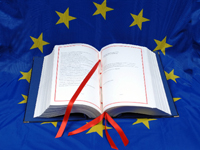Lisbon treaty 2009 - Irish referendum
What is the Lisbon treaty, and what does it do?
by Daniel Finnan
Article published on the 2009-09-28 Latest update 2009-09-28 14:31 TU
The Lisbon Treaty supplements the existing European Community treaty, the Treaty of Rome, and the European Union treaty the Maastricht treaty, and it replaces the originally tabled EU Constitution agreed in Brussels in 2004 (which was then rejected by the French and Dutch in referendums a year later).
Plans to introduce a new legal framework for the Union were rejected in in the first Irish referendum in June 2008 by 53 per cent of the electorate. It had been hoped the treaty would be in place before 2009 European Elections, but instead, the Union awaits the result of this second Irish referendum.
The treaty promises a greater role for the European Parliament, of which Ireland has 12 MEPs. It also creates new powers over legislation, the budget and international agreements, but removes a number of national vetoes on EU measures.
The treaty would also create a new position of President of the European Council, with an elected official being appointed every two and half years. Former British Prime Minister Tony Blair has been discussed as a possible candidate for this post.
Voting majorities in the Council will be changed so that a decision is taken if 55 per cent of the member states representing 65 per cent of the Union’s population agree.
And a new initiative would give citizens a greater voice, with the possibility of changes in EU law through one million signatories to a supported policy proposal.
The treaty introduces the Charter of Fundamental Rights into primary European law and emphasises solidarity between member states on issues such as terrorism, disasters and energy. There are also new provisions on civil protection, humanitarian aid and public health.
Work on a global stage will also be improved by the appointment of a Foreign Affairs and Security Policy chief, and External Action Service. And for the first time it explicitly outlines the possibility of withdrawal from the Union by member states.






